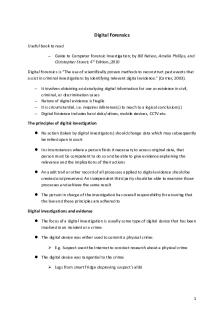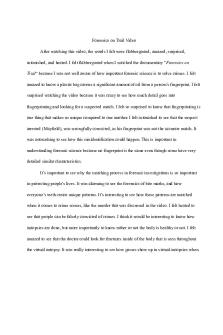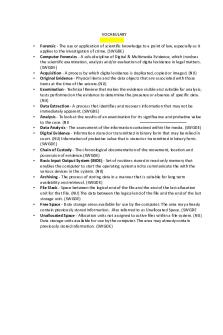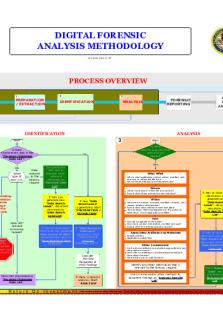Forensics Chapter 1 PDF

| Title | Forensics Chapter 1 |
|---|---|
| Course | Introduction to Forensics |
| Institution | Liberty University |
| Pages | 5 |
| File Size | 77.1 KB |
| File Type | |
| Total Downloads | 47 |
| Total Views | 163 |
Summary
chapter 1 textbook notes...
Description
Chapter 1 Introduction
FORENSIC SCIENCE & ITS ROLE IN THE JUSTICE SYSTEM ● ● ● ● ● ● ● ● ● ● ● ●
Forensic science is science in service of the law Forensic= “having to do with the law” Forensics= “debating” (not the same as forensic science) Before the last 30 year it has served to confirm identifications and the nature of well-defined evidence items. Computerized databases are the largest factor that has changed the need for forensic science. ○ Began with the development of automated identification systems. Fingerprint identification systems were initially private but became a gov’t sponsored activity. ○ Systems can make use of 10-print fingerprint cards and latent fingerprints All states have access to fingerprint database and are interconnected through the federal system. Databases have expanded and now collect DNA through the CODIS database. ○ CODIS= Combined DNA Indexing System Forensic-based databases are expanding in areas such as firearms-related and trace evidence-based databases. Forensic science labs work on criminal and civil cases. ○ Civil ex. Product failure liability, paternity resolutions Most public forensic science labs are supported by municipalities, counties, states gov’ts or the federal gov’t Broad term for different scientific and technological specialty areas
CONTRIBUTIONS PROVIDED BY FORENSIC LABS ●
●
●
●
●
Aid in investigation of incidents of possible legal interest ○ Work submitted to and done in forensic labs is post facto (after crime committed and suspect is arrested) Help establish basic legal elements of a crime ○ Corpus delicti= body or “element” of crime ○ Elements are things that prosecutor is obligated to prove beyond reasonable doubt to gain conviction ○ Must prove all required elements of crime Support or disprove statements my witnesses, victims or suspects ○ If physical evidence and analysis shows somethings that contradicts a statement by someone in a case, the statement is incorrect Identify substances or materials ○ Examination of physical evidence provides identification of a substance or material. ○ Ex. Controlled substance possession or counterfeiting case Identify persons ○ Automated Fingerprint Identification System (AFIS) contains known fingerprints and evidentiary fingerprints not yet identified ○ National Integrated Ballistic Identification Network (NIBIN) contains image data from bullets and cartridge cases from known weapons seized in cause and from evidence collected in unsolved
cases
HISTORY OF FORENSIC SCIENCE ● ● ● ●
●
Early work on forensic medicine was published in China (AD 1250) Formal beginnings in the west began between 1800 and 1850. Has become less experience-based and more scientifically based. Hans Gross ○ responsible for the word “criminalistics” ○ Magistrate and law professor (had the role as judge and primary investigator) ○ First to consider the value of physical evidence Alphonse Bertillon ○ Developed a method for criminal identification based on body measurements (kept on file of people who were arrested or incarcerated)
DEVELOPMENT OF LABS AND ORGANIZATIONS ● ●
●
●
●
● ● ●
August Vollmer ○ Responsible for starting first forensic lab for LAPD Law Enforcement Assistance Administration ○ Set up by federal gov’t as a result of Safe Streets Act of 1968 ○ Provided funding to state and local jurisdictions to start labs or expand/improve existing labs. American Academy of Forensic Sciences (AAFS) ○ Formed by small group of pathologists, psychiatrists, criminalists, and attorneys led by Gradwohl of St. Louis in 1948 ○ Sections representing 11 forensic disciplines and specialties International Association for Identification (IAI) ○ Formally incorporated in 1919 ○ Fingerprint examiners and pattern evidence specialist belong to this association American Society of Crime Laboratory Directors (ASLD) ○ Was formed by a group of crime lab directors with an assist from the FBI (1970s) ○ Developed a system of voluntary lab accreditation (1982) Starting in 1994 concerns over complexities of DNA analysis made accreditation of DNA sections mandatory Accreditation applies to labs while certifications apply to individuals American Board of Criminalist (ABC) ○ Most extensive program for criminalists
HUMAN BIOLOGICAL AND MEDICAL SCIENCES ●
Forensic pathology ○ Doctors of Medicine (MD) who have specialized in pathology then take training in forensic pathology ○ Determines the cause and manner of death ■ Cause: medical determination and explanation for why a person died (ex. Gunshot wound) ■ Manner (circumstances): medico-legal determination (ex. Homicide)
●
●
●
●
●
■ Sometimes cause and manner of death can be undetermined 2 systems of death investigation ○ Coroner: elected official, does not need special medical known of training because the can call specialist to assist in determinations, has the power to convene a coroner’s inquest to take sworn testimony at proceeding ○ Medical examiner: forensic pathologist with medical training who makes determinations of death, determinations are based on all available info about a death Entomology ○ Study of insects ○ Entomologists know life cycles of insects in detail and how long each stage takes ■ Time is governed by temperature and the length of daylight of each day ○ Can examine eggs larvae or pupae from a body to determine what species of insect produced them ○ Eggs and larvae must be collected and kept until the adult stage to be identified ○ Able to “back calculate” to estimate the time of death by using info about the number of insect cycles, temperature, daylight hours and other info from the scene Forensic odontologists ○ Forensic dentists ○ Identify human remains that are altered by decomposition, fire or explosion and cannot be identified by visuals ○ Look at pre-mortem and post-mortem dental X-rays ○ Dental work done on an individual is unique enough to permit personal identification ○ Look at bitemark comparisons ■ May be found of human bodies in cases of assault, and child abuse ■ Can be compared with known bitemarks obtained from suspects Physical anthropology ○ Study of human skeleton and how it has evolved over time ○ Specialize in examining human skeletal remains ○ Determines of skeletal remains are human or animal and estimate when they were deposited ○ Human remains can be “reconstructed” ■ Laid out in proper orientation ○ Provide estimate of age, stature and gender of individual ○ Can tell if remains belong to the Caucasoid, negroid or mongoloid race ○ Spot skeletal abnormalities and skeletal trauma ■ Can determine the cause of death ○ Sub-specialty referred to “forensic sculpture” or cranio-facial reconstruction Forensic toxicology ○ Study of extraneous materials in the body (ex. Poison, toxins and drugs) ○ Determine the presence and amounts of material in body and attempt to interpret possible effects of materials ○ Knowledgeable in analytical chemistry techniques as well as biology, physiology and pharmacology ○ Often associated with medical examiners’ office
NATURAL SCIENCES: CHEMISTRY, BIOLOGY AND PHYSICS ●
Criminalistics: term used to cover all natural science approaches to evidence examination ○ Criminalist is a person who thinks about a case and evidence in specific ways
TECHNOLOGY AND ENGINEERING ●
Forensic engineers ○ Involved in reconstructing automobile and other transportation accidents, material failure cases and building/structure collapses ○ More involved in civil cases
SCIENTIFIC METHOD: FOUR STEP PROCESS ● ● ● ●
Careful observation Make logical suppositions to explain observations Hypothesis testing (controlled experiments) Refine hypothesis
ELEMENTS OF FORENSIC EVIDENCE ANALYSIS ●
●
●
Evidence reconstruction ○ Recognition of physical objects as evidence or potential evidence is the first step in investigation/analysis Classification(identification) ○ Process of categorizing object within a group of similar objects ○ Chemical evidence examination in forensic lab consists exclusively of classification ■ Chemical or instrumental techniques are required to establish classifications and are required by court to sustain prosecution Individualization ○ Can mean 2 things: Examine characteristics of something to re recognized as unique among members of its class OR when a “questioned: or unknown object is compared with a “known” or exemplar item, they are found to have a common origin ○ Narrowing of classification until only one item remains in the class ○ Restricted to human identification, fingerprints, certain patterns and jigsaw fit matches ○ “partial individualization”: a narrowing of classification, but not to the point of exclusivity ○ Exclusions are absolute ■ If there are unexplained differences in observed characteristics between the questioned and the known, the known is excluded as a source of the questioned ■ Could not have a common origin ■ Exclusionary findings are fill or partial individualization ■ Cause investigation to be redirected or show the accused or convicted is innocent
●
Reconstruction ○ Uses of physical evidence and analysis to understand events that produced the evidence ○ Possibility of incorrect interpretation in reconstruction is higher than other types of forensic analysis ○ Corroboration is an important application of reconstruction ○ Observations and possible scenarios must be tested against hypothesis (potential reconstruction) ○ Reconstruction is a hypothesis or theory of events
ETHICAL CONCERNS AND PROFESSIONAL PRACTICE ●
● ● ● ●
American Academy of Forensic Sciences (AAFS) ○ Guidelines for forensic scientist who belong to the academy ○ Code is broad because it is designed for a variety of practitioners of many specialties in private practice or different levels of gov’t ○ 11 sections that covers every aspect of forensic science United States is divided into 8 regions, each has its own professional organization National organization has 11 sections ○ Also have specialty groups Each organization has its own code to self-police its members and sanctions those who do not follow the code Forensic scientists muse not testify beyond their expertise...
Similar Free PDFs

Forensics Chapter 1
- 5 Pages

Chapter 1-11 forensics
- 39 Pages

Forensics Notes (1) (1) (1)
- 24 Pages

- BN - Forensics
- 1 Pages

UNIT 1 TEXT Questions Forensics
- 2 Pages

Forensics Crash Course
- 1 Pages

Forensics Welcome Intrusion
- 1 Pages

Digital Forensics Reports
- 4 Pages

Digital Forensics Intro
- 9 Pages

Forensics on Trail Video
- 2 Pages

Digital Forensics Vocabulary
- 1 Pages

forensics study notes
- 11 Pages

Answer Bank Cyber Forensics
- 73 Pages
Popular Institutions
- Tinajero National High School - Annex
- Politeknik Caltex Riau
- Yokohama City University
- SGT University
- University of Al-Qadisiyah
- Divine Word College of Vigan
- Techniek College Rotterdam
- Universidade de Santiago
- Universiti Teknologi MARA Cawangan Johor Kampus Pasir Gudang
- Poltekkes Kemenkes Yogyakarta
- Baguio City National High School
- Colegio san marcos
- preparatoria uno
- Centro de Bachillerato Tecnológico Industrial y de Servicios No. 107
- Dalian Maritime University
- Quang Trung Secondary School
- Colegio Tecnológico en Informática
- Corporación Regional de Educación Superior
- Grupo CEDVA
- Dar Al Uloom University
- Centro de Estudios Preuniversitarios de la Universidad Nacional de Ingeniería
- 上智大学
- Aakash International School, Nuna Majara
- San Felipe Neri Catholic School
- Kang Chiao International School - New Taipei City
- Misamis Occidental National High School
- Institución Educativa Escuela Normal Juan Ladrilleros
- Kolehiyo ng Pantukan
- Batanes State College
- Instituto Continental
- Sekolah Menengah Kejuruan Kesehatan Kaltara (Tarakan)
- Colegio de La Inmaculada Concepcion - Cebu


